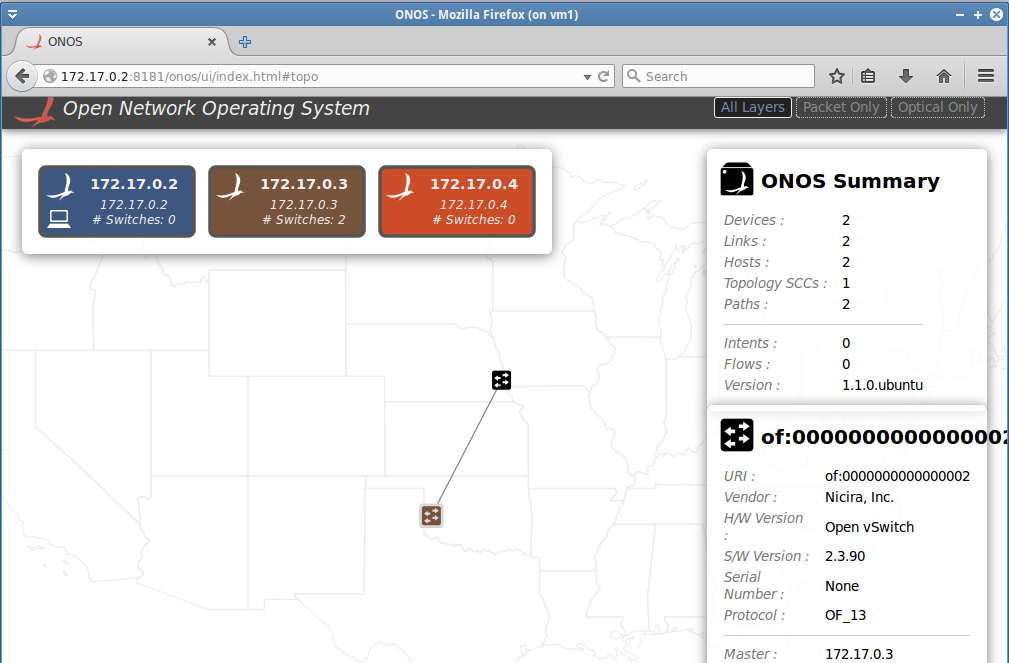

ONOS, Open Network Operating System, is a newly released open-source SDN controller that is focused on service provider use-cases. Similar to OpenDaylight, the platform is written in Java and uses Karaf/OSGi for functionality management. Recently we experimented with this controller platform and put together a basic ONOS tutorial that explores the platform and its current features.
For experimenting with ONOS, we provide two options for obtaining a pre-compiled version of ONOS 1.1.0:
- Our tutorial VM that starts the ONOS feature onos-core-trivial when karaf is run.
- A Docker repository sdnhub/onos where containers start the ONOS feature onos-core when karaf is run. (Alternatively, here is the Dockerfile)
Clustering
In this post, we experiment more with the clustering feature where multiple instances of the controller can be clustered to share state and manage a network of switches. ONOS uses Hazelcast for clustering multiple instances. To experiment with clustering, we perform the following commands to spin up three containers running the ONOS controller in daemon mode:
$ sudo docker pull sdnhub/onos $ for i in 1 2 3; do sudo docker run -i -d --name node$i -t sdnhub/onos; done $ sudo docker ps CONTAINER ID IMAGE COMMAND PORTS NAMES 7a6e01a3c174 sdnhub/onos:latest "./bin/onos-service" 6633/tcp, 5701/tcp node3 92cdc5713b6a sdnhub/onos:latest "./bin/onos-service" 5701/tcp, 6633/tcp node2 7731779512b4 sdnhub/onos:latest "./bin/onos-service" 6633/tcp, 5701/tcp node1
Hazelcast uses IP multicast to find the other member nodes. In the above system, you can check who the members are by connecting to one of the Docker containers:
$ sudo docker attach node1 onos> feature:list -i | grep onos Name | Installed | Repository | Description ----------------------------------------------------------------------------------------------------- onos-thirdparty-base | x | onos-1.1.0-SNAPSHOT | ONOS 3rd party dependencies onos-thirdparty-web | x | onos-1.1.0-SNAPSHOT | ONOS 3rd party dependencies onos-api | x | onos-1.1.0-SNAPSHOT | ONOS services and model API onos-core | x | onos-1.1.0-SNAPSHOT | ONOS core components onos-rest | x | onos-1.1.0-SNAPSHOT | ONOS REST API components onos-gui | x | onos-1.1.0-SNAPSHOT | ONOS GUI console components onos-cli | x | onos-1.1.0-SNAPSHOT | ONOS admin command console components onos-openflow | x | onos-1.1.0-SNAPSHOT | ONOS OpenFlow API, Controller & Providers onos-app-fwd | x | onos-1.1.0-SNAPSHOT | ONOS sample forwarding application onos-app-proxyarp | x | onos-1.1.0-SNAPSHOT | ONOS sample proxyarp application onos> onos> summary node=172.17.0.2, version=1.1.0.ubuntu~2015/02/08@14:04 nodes=3, devices=0, links=0, hosts=0, SCC(s)=0, paths=0, flows=0, intents=0 onos> masters 172.17.0.2: 0 devices 172.17.0.3: 0 devices 172.17.0.4: 0 devices onos> nodes id=172.17.0.2, address=172.17.0.2:9876, state=ACTIVE * id=172.17.0.3, address=172.17.0.3:9876, state=ACTIVE id=172.17.0.4, address=172.17.0.4:9876, state=ACTIVE
We can see three controllers clustered when we list the summary and nodes. The star next to 172.17.0.2 designates that node as the leader for the state.
Now we start mininet emulated network with 2 switches, and point them to the controller running in container node2. Since the sample forwarding application is installed, you will see that the ping between two hosts succeeds.
$ sudo mn --topo linear --mac --switch ovsk,protocols=OpenFlow13 --controller remote,172.17.0.3 mininet> h1 ping h2 -c 1 PING 10.0.0.2 (10.0.0.2) 56(84) bytes of data. 64 bytes from 10.0.0.2: icmp_seq=1 ttl=64 time=0.549 ms --- 10.0.0.2 ping statistics --- 1 packets transmitted, 1 received, 0% packet loss, time 0ms rtt min/avg/max/mdev = 0.549/0.549/0.549/0.000 ms
We can visit the web UI of any of the controllers (e.g., http://172.17.0.2:8181/onos/ui/index.html) and get the same information in a graphical format, as shown on the right side..

OpenFlow Roles and Fault tolerance
So far, all three controller are in active mode, with only the controller in node2 being the OpenFlow controller used for the devices. Let’s change that and verify that the system can function with multiple controllers with one being the OpenFlow master and others being the slave.
- Add all controllers to all switches/devices, while mininet is running
$ sudo ovs-vsctl set-controller s1 tcp:172.17.0.4:6633 tcp:172.17.0.3:6633 tcp:172.17.0.2:6633
$ sudo ovs-vsctl set-controller s2 tcp:172.17.0.4:6633 tcp:172.17.0.3:6633 tcp:172.17.0.2:6633
$ sudo ovs-vsctl show
873c293e-912d-4067-82ad-d1116d2ad39f
Bridge "s1"
Controller "tcp:172.17.0.3:6633"
is_connected: true
Controller "tcp:172.17.0.4:6633"
is_connected: true
Controller "tcp:172.17.0.2:6633"
is_connected: true
fail_mode: secure
Port "s1-eth2"
Interface "s1-eth2"
Port "s1"
Interface "s1"
type: internal
Port "s1-eth1"
Interface "s1-eth1"
Bridge "s2"
Controller "tcp:172.17.0.3:6633"
Controller "tcp:172.17.0.2:6633"
Controller "tcp:172.17.0.4:6633"
fail_mode: secure
Port "s2-eth2"
Interface "s2-eth2"
Port "s2-eth1"
Interface "s2-eth1"
Port "s2"
Interface "s2"
type: internal
ovs_version: "2.3.90"
- Verify ONOS state from the Karaf CLI, especially check the updated list of OpenFlow roles
$ sudo docker attach node1 onos> masters 172.17.0.2: 0 devices 172.17.0.3: 1 devices of:0000000000000001 172.17.0.4: 1 devices of:0000000000000002 onos> roles of:0000000000000001: master=172.17.0.3, standbys=[ 172.17.0.4 172.17.0.2 ] of:0000000000000002: master=172.17.0.4, standbys=[ 172.17.0.3 172.17.0.2 ]
- Now let’s bring down node2, and see what happens.
$ sudo docker stop node2 $ sudo docker attach node1 onos> nodes id=172.17.0.2, address=172.17.0.2:9876, state=ACTIVE * id=172.17.0.3, address=172.17.0.3:9876, state=INACTIVE id=172.17.0.4, address=172.17.0.4:9876, state=ACTIVE onos> masters 172.17.0.2: 0 devices 172.17.0.3: 0 devices 172.17.0.4: 2 devices of:0000000000000001 of:0000000000000002 onos> roles of:0000000000000001: master=172.17.0.4, standbys=[ 172.17.0.2 ] of:0000000000000002: master=172.17.0.4, standbys=[ 172.17.0.3 172.17.0.2 ]
We notice that the controller in node3 has become the master OpenFlow controller for all two switches. We also noticed that the ping (h1 ping h2) succeeds in the mininet system! We further removed node1 and verified that the system still functions fine with 1 controller and 1 state keeper. This is the power of clustering.